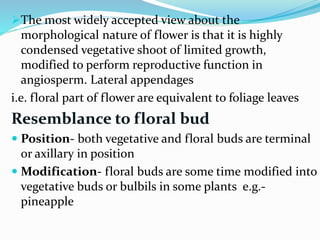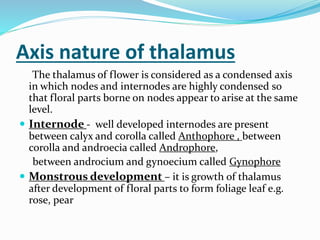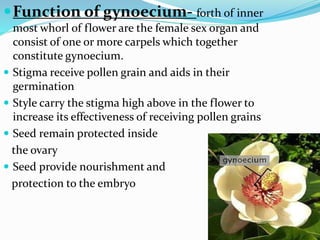Flower as shoot modification
- 1. Submitted to- Deepika mam Submitted by- arun saini Class ©Cb.sc medical Roll no.-1369610054
- 2. ?The most widely accepted view about the morphological nature of flower is that it is highly condensed vegetative shoot of limited growth, modified to perform reproductive function in angiosperm. Lateral appendages i.e. floral part of flower are equivalent to foliage leaves Resemblance to floral bud ? Position- both vegetative and floral buds are terminal or axillary in position ? Modification- floral buds are some time modified into vegetative buds or bulbils in some plants e.g.- pineapple
- 3. Axis nature of thalamus The thalamus of flower is considered as a condensed axis in which nodes and internodes are highly condensed so that floral parts borne on nodes appear to arise at the same level. ? Internode - well developed internodes are present between calyx and corolla called Anthophore , between corolla and androecia called Androphore, between androcium and gynoecium called Gynophore ? Monstrous development ©C it is growth of thalamus after development of floral parts to form foliage leaf e.g. rose, pear
- 4. LEAFY NATURE OF FLORAL PARTS ? Phyllotaxy ©C the arrangment of floral leaves on the thalamus resemble to that of foliage leaves . E.g. lily ,cactus ? Aestivation ©C floral leaves exhibit the aestivation similar to that of foliage leaves. ? The stamen of some primitive flowers are expanded like leaves. ? Like wise of carpels degeneria do not bear distict style and stigma. They appear like partially rolled up leaves
- 5. Function of floral parts Function of calyx- the outer whorl of flower consist of sepals which together constitute calyx. ? Calyx provide support and protection to the thalamus and inner floral whorls ? Green calyx perform the fuction of photosynthesis ? When bright coloured , calyx aids in pollination. ? Modification of calyx in some perform special fuction e.g. spinous in protection
- 6. Function of corolla- second inner whorl of floral parts consist of petals which together constitute corolla ? Corolla protects the inner essential whorl in bud conditon and even after opening of flower ? Bright colour and presence of scent and nector serecting gland attract pollinators ? Shape size and various other devices in corolla regulate the entry of insect or bud pollinators
- 7. ?Function of androecium ©C ? third whorl of floral parts called stamens together constitute androcium. ? Stamen are male sex organ in the flower anther produce a large no. of pollen grain ? Whorls of anther also aids in dispersal of pollen grain.
- 8. ?Function of gynoecium- forth of inner most whorl of flower are the female sex organ and consist of one or more carpels which together constitute gynoecium. ? Stigma receive pollen grain and aids in their germination ? Style carry the stigma high above in the flower to increase its effectiveness of receiving pollen grains ? Seed remain protected inside the ovary ? Seed provide nourishment and protection to the embryo







